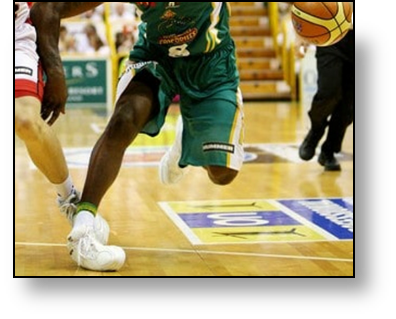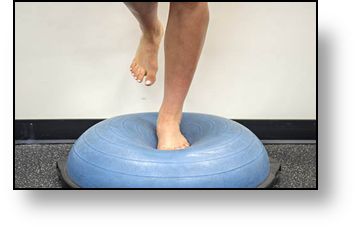09/29/2022
Ankle Sprains and Chronic Instability
By Sarah Tompkins, PT, MPT, FAAOMPT, Wentworth-Douglass Rehabilitation Services
Lateral ankle sprains are the most common foot-ankle sports related injury for which people seek care. Ankle sprains are common in indoor court sports like basketball and volleyball while field sports have a lower rate of occurrence. However, only about 50% of people who sustain this type of injury seek medical attention.

If you twist your ankle, mis-stepped on the court or are unfortunate to not see that hole in the back yard and wrenched your ankle resulting in a black and blue, swollen ankle, then it might be smart to consult your healthcare provider.
Most people will just search the internet and do the usual recommendations of “RICE” Rest, Ice, Compression, Elevation and then start walking on the ankle as the pain disappears and call it good. But there are some factors which might lead to recurring ankle sprains. Some of the risk factors are being female, having poor gluteal strength, poor performance on balance and hop tests, participating in court sports, having a higher BMI, and not taping or bracing prior to having an ankle injury can lead to chronic ankle instability.
Unfortunately, there can be more complicated outcomes from a Lateral ankle sprain (LAS) than meets the eye. A recent longitudinal study found that 60% of individuals achieve resolution of activity limitations and sport participation by the 12-month mark, but that 40% progress to Chronic ankle instability (CAI). CAI may have varying amounts of mechanical instability due to connective tissue impairment and sensorimotor impairment. Therefore, it is important to see your physician and possibly a physical therapist or athletic trainer at your school if your ankle has been giving way after evidence of the initial acute injury subsides.
Physical therapists can assess an acute LAS and offer information on bracing or taping, or an assistive device based on the severity of the injury and then provide a rehabilitation program with structured therapeutic exercises which promote tissue healing, protective active ROM, stretching, neuromuscular training, balance training, in both the clinic and home to optimize your return to sport or work activity.
Altered walking mechanics, or ankle impingement, which can cause pain and limited motion, was found in 25% of individuals after a LAS. Potentially, results from soft tissue injury and/or posttraumatic joint alterations can lead to mechanical stiffness of the ankle joint and result in abnormal kinematics and symptoms. Manual therapy techniques which are hands on treatment can improve lymphatic drainage, joint mobility, and normalize the articulations of the ankle joint preventing subsequent ankle injury.
Female high school and collegiate athletes had significantly higher prevalence of CAI than their male counterparts. A 2014 study found that the prevalence of instability was significantly higher in high school athletes than in collegiate athletes. In collegiate athletes, nearly 12% of reported ankle sprains were recurrent. These recurrent sprains were most often sustained in athletes participating in women's basketball, outdoor track, field hockey and men's basketball.
If CAI becomes a problem, then a skilled physical therapist can guide a patient toward improved load on the ankle with less giving way with temporary bracing in the short term after ankle injury and providing graded exercises which emphasize coordination, postural stability, single limb balance activities on unstable surfaces manual therapy to improve ROM of the ankle and eventual jump and landing on the impaired ankle without fear of reinjury.
 Ultimately, clinicians can prescribe proprioceptive and neuromuscular therapeutic exercise to improve dynamic postural stability and patient-perceived stability during function in individuals with CAI. While external supports are recommended for prevention of the initial injury, the use of external support as a sole treatment intervention after injury is insufficient to promote sustained improvements in balance and postural stability in people with CAI. Seeking out your healthcare provider’s advice, may prevent future injuries.
Ultimately, clinicians can prescribe proprioceptive and neuromuscular therapeutic exercise to improve dynamic postural stability and patient-perceived stability during function in individuals with CAI. While external supports are recommended for prevention of the initial injury, the use of external support as a sole treatment intervention after injury is insufficient to promote sustained improvements in balance and postural stability in people with CAI. Seeking out your healthcare provider’s advice, may prevent future injuries.
 About Sarah Tompkins PT, MPT, FAAOMPT:
About Sarah Tompkins PT, MPT, FAAOMPT:
Sarah is a clinical specialist at Wentworth-Douglass Hospital. She works at the outpatient orthopedic clinic at Pease. Prior to becoming a physical therapist, she was a professional ballet dancer for 10 years.
She has been a practicing physical therapist for 22 years and has been recently working with the Woman’s Sports Medicine program at Wentworth-Douglass. After suffering my fair share of ankle injuries as a dancer, I have always had an interest in treating ankle and foot injuries for other athletes. She now enjoys biking, hiking, and small group Pilates classes.
Tagged In: